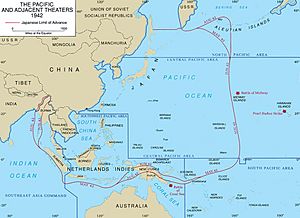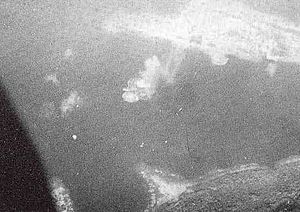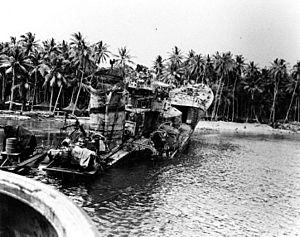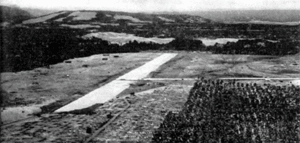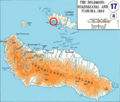Invasion of Tulagi (May 1942) facts for kids
The invasion of Tulagi, on May 3–4, 1942, was a key part of Operation Mo. This was Japan's plan to expand its control in the South Pacific during World War II. Japanese forces aimed to capture Tulagi and nearby islands in the British Solomon Islands Protectorate.
Japan wanted Tulagi for several reasons. It would protect their advance on Port Moresby in New Guinea. It would also make their main base at Rabaul stronger. Most importantly, Tulagi would serve as a base to threaten the supply routes between the United States and Australia and New Zealand.
The British and Australian defenders on Tulagi could not stop the Japanese. They evacuated the island just before the Japanese arrived on May 3. However, the next day, a U.S. aircraft carrier group was on its way to stop the Japanese advance on Port Moresby. This group launched an air attack on the Japanese forces at Tulagi. They damaged or destroyed several Japanese ships and planes.
Despite the attack, Japanese troops successfully took Tulagi. They quickly began building a small naval base. Over the next few months, they set up a base for refueling ships, communications, and seaplanes. They also started building a large airfield on nearby Guadalcanal in July 1942.
Allied reconnaissance aircraft and Australian Coastwatchers watched these Japanese activities. Since these bases threatened Allied supply lines, Allied forces launched their own attack. They landed on Guadalcanal and Tulagi on August 7, 1942. This started the important Guadalcanal campaign. This campaign, along with the New Guinea campaign, helped decide the war's outcome in the South Pacific.
Quick facts for kids Invasion of Tulagi |
|||||||||
|---|---|---|---|---|---|---|---|---|---|
| Part of the Pacific Theater of World War II | |||||||||
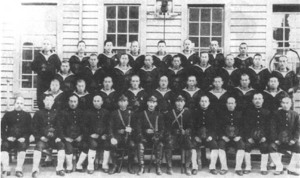 Japanese officers and petty officers of the 3rd Kure Special Naval Landing Force that seized Tulagi in May 1942 |
|||||||||
|
|||||||||
| Belligerents | |||||||||
| Allied forces including: |
|||||||||
| Commanders and leaders | |||||||||
| Strength | |||||||||
| 1 aircraft carrier, 3 cruisers, 4 destroyers, 58 aircraft |
2 destroyers, 5 minesweepers, 2 minelayers, 1 transport ship, 2 subchasers, 6 aircraft, 400–500 troops |
||||||||
| Casualties and losses | |||||||||
| 4 aircraft destroyed | 1 destroyer, 3 minesweepers sunk, 2 minelayers, 1 destroyer damaged, 1 transport damaged, 5–6 aircraft destroyed, 87 killed |
||||||||
Contents
Why Tulagi Was Important
On December 7, 1941, Japan attacked the U.S. fleet at Pearl Harbor in Hawaii. This attack severely damaged many U.S. battleships and started the war between the two nations. Japan's leaders wanted to weaken the American fleet. They also aimed to seize areas rich in natural resources and gain strategic military bases. Soon after, other countries like the United Kingdom, Australia, and New Zealand joined the U.S. as Allies against Japan.
Japan's initial war goals were to remove British and American power from the Netherlands East Indies and the Philippines. They wanted to create a self-sufficient empire. In early 1942, Japanese forces took control of the Philippines, Thailand, Malaya, Singapore, the Netherlands East Indies, and other islands.
Vice Admiral Shigeyoshi Inoue, who commanded Japan's 4th Fleet, suggested taking Lae, Salamaua, and Port Moresby in New Guinea. He also wanted to capture Tulagi in the Solomon Islands. Inoue believed controlling these places would make Japan's main base at Rabaul much safer. Japan's Naval General Staff agreed with Inoue. They began planning more operations. They aimed to take Nauru, Ocean Island, New Caledonia, Fiji, and Samoa. This would cut off supply lines between Australia and the U.S. and weaken Australia as a threat.
The Imperial Japanese Army supported the plan to take Port Moresby. In April 1942, they worked with the Japanese Navy to create "Operation Mo". This plan also included taking Tulagi. A seaplane base would be built there for air operations against Allied areas. Japanese Admiral Isoroku Yamamoto was planning another big battle to draw out the U.S. fleet. But he still sent some of his warships to support Operation Mo. He put Inoue in charge of the naval part of the operation.
A large Japanese naval force was assembled for Operation Mo. It included two heavy aircraft carriers, one light carrier, and many other ships. This force was meant to protect the Port Moresby invasion and fight any Allied warships. The Tulagi invasion force left Rabaul on April 30. It was led by Rear Admiral Kiyohide Shima. This force included two destroyers, minelayers, minesweepers, and transport ships.
Rear Admiral Aritomo Gotō provided air cover for the Tulagi invasion. His group included the light carrier Shōhō. Another group, led by Rear Admiral Kuninori Marumo, also supported the invasion. Once Tulagi was secure, these groups would help cover the Port Moresby invasion.
Tulagi was the capital of the British Solomon Islands Protectorate. William Sydney Marchant, the British Resident Commissioner, ordered most white civilians to evacuate in February 1942. Marchant himself moved to Malaita to help with a coastwatcher station.
The only Allied military forces on Tulagi were 24 Australian commandos and about 25 Australian Air Force personnel. They operated a seaplane base on nearby Gavutu-Tanambogo with four Catalina patrol planes. Three Allied coastwatchers were also on Guadalcanal. Their job was to report any enemy movements. To protect them from being executed as spies, the coastwatchers were made officers in the Royal Australian Naval Volunteer Reserve.
Japanese Bombing and Allied Warnings
Throughout April, Japanese planes from Rabaul bombed Tulagi. These raids caused little damage. Coastwatchers on Guadalcanal usually gave advance warning to the Australian troops. But the troops had only a few machine guns and could not seriously challenge the Japanese bombers. On April 25, eight Japanese planes bombed Tulagi. Similar raids happened daily. On May 1, one raid heavily damaged a Catalina at Gavutu. The remaining Catalinas left that same day.
Allied intelligence had learned about Japan's Operation Mo plans. They used radio intercepts from intelligence centers in Melbourne, Australia, and Pearl Harbor, Hawaii. Based on this, U.S. Admiral Chester Nimitz ordered Allied forces to the Coral Sea on April 22. They were to stop the Japanese operation.
On April 27, the U.S. aircraft carrier USS Yorktown's Task Force 17 (TF 17) left Tonga. It was commanded by Rear Admiral Frank Jack Fletcher. On May 1, it met the U.S. carrier USS Lexington's TF 11. Fletcher then sent TF 11 to refuel. He expected to rejoin Lexington on May 4 in the Coral Sea.
Landings and Air Attacks
On May 2, coastwatcher Jack Read on Bougainville reported a large Japanese force leaving the Buka area. Later that day, coastwatcher D. G. Kennedy on New Georgia island saw and reported a large Japanese force heading towards the southern Solomons. Soon after, the Australian commanders on Tulagi, Captain A. L. Goode and F/O R. B. Peagam, ordered an evacuation. They began destroying their equipment and facilities.
The Australian personnel left on two small ships early on May 3. They were heading to Vila, New Hebrides. Just as they left, Shima's ships entered Savo Sound to begin their landings on Tulagi. The ship with the Australian Air Force personnel spent the day with coastwatcher Martin Clemens on Guadalcanal. They departed that night.
Japanese seaplanes from Kamikawa Maru supported the landings. They were temporarily based at Thousand Ships Bay. About 400 Japanese naval troops, mostly from the 3rd Kure Special Naval Landing Force, landed from a transport ship. They immediately began building facilities on Tulagi and Gavutu-Tanambogo. Aircraft from Shōhō covered the landings until early afternoon. Then, Gotō's force turned towards Bougainville to refuel. Six seaplanes landed in Tulagi harbor to set up the planned seaplane base.
At 5:00 PM on May 3, Fletcher learned that the Japanese Tulagi invasion force had been sighted. He could not communicate with the Lexington task force because of radio silence. So, Yorktown's task force headed independently towards Guadalcanal. They wanted to be in position to launch air strikes against the Japanese at Tulagi the next morning.
At 7:01 AM on May 4, Yorktown launched its first attack. It consisted of 12 torpedo bombers and 28 dive bombers. They were about 160 km (100 mi) south of Guadalcanal. The planes began attacking Shima's ships near Tulagi at 8:50 AM. The Japanese ships were caught by surprise while anchored.
Okinoshima and two destroyers were positioned to protect Azumasan Maru and Kōei Maru, which were unloading troops. The three minesweepers had just started moving to support the Port Moresby invasion. U.S. pilots claimed many hits. They actually hit only Okinoshima, causing minor damage, and Kikuzuki, causing major damage. Kikuzuki was beached on Gavutu to prevent her from sinking. Other Japanese ships tried to escape the harbor. One U.S. dive bomber destroyed a Japanese floatplane trying to take off.

Yorktown's second attack, using the same planes, returned to Tulagi at 12:10 PM. Many Japanese ships were now moving at full speed, trying to get away. The second attack hit and sank minesweepers #1 and #2. It also severely damaged Tama Maru northeast of Savo Island. Another Japanese seaplane was shot down. Four Wildcat fighters from Yorktown joined the attack. They shot down two more Japanese floatplanes over Florida Island. The fighters then attacked Yūzuki, killing her captain and nine crew members, and causing moderate damage. Two or three other Japanese floatplanes were damaged in Tulagi harbor, and their crews were killed.
A third, smaller attack from Yorktown arrived at 3:30 PM. It caused moderate damage to Azumasan Maru and Okinoshima. One U.S. torpedo bomber got lost, ran out of fuel, and crashed into the ocean south of Guadalcanal. Two Wildcats also ran out of fuel and crash-landed on Guadalcanal's southern coast. Fletcher sent the destroyers USS Hammann and Perkins to rescue the aircrews. Hammann rescued both fighter pilots. Perkins could not find the torpedo bomber's crew. Both destroyers returned to Yorktown's task force late that evening. The task force then turned southeast to refuel and meet Lexington the next day.
What Happened Next
On May 5, Kikuzuki slid off the shore of Gavutu and sank in Tulagi harbor. Tama Maru sank two days later. The other damaged Japanese ships reached Rabaul and Kavieng for repairs. On May 10, Okinoshima was sunk by the submarine USS S-42 during a Japanese attempt to take Ocean and Nauru Islands. A total of 87 Japanese naval personnel died in the May 4 air attacks on Tulagi. Thirty-six landing troops were seriously injured.
The lost Yorktown aircrew, Leonard Ewoldt and Ray Machalinsk, reached Guadalcanal after three days adrift. A Catholic missionary, Father Jean Boudard, took them to Martin Clemens. Clemens arranged for a boat to take them to San Cristobal. From there, another boat took them to the New Hebrides, and they eventually rejoined U.S. forces.
After attacking Tulagi, Yorktown rejoined Lexington. The two carriers fought the rest of the Japanese forces in the Mo operation from May 6–8 in the Battle of the Coral Sea. In this battle, Lexington was sunk, and Yorktown was damaged. The Japanese lost Shōhō and had a fleet carrier heavily damaged. They also suffered heavy losses of carrier aircraft and aircrews. Fearing more attacks and unable to provide enough air cover, the Japanese turned back from their planned assault on Port Moresby. They intended to try again later.
However, the next Japanese attempt to take Port Moresby by sea never happened. This was mainly because of their navy's defeat in June at the Battle of Midway. Instead, the Japanese tried to take Port Moresby with an overland attack along the Kokoda Track. This attack was ultimately unsuccessful. The failure to take Port Moresby in May 1942 had big consequences. Many of these involved the small Japanese naval base at Tulagi.
Despite the damaging air attacks, the Japanese continued building their seaplane base at Tulagi and Gavutu. They received more troops and construction workers over the next few months. The base soon became operational. Aircraft from the Yokohama Air Group began reconnaissance patrols on May 6. On May 27, the Japanese looked at the Lunga Point area on Guadalcanal. They thought it might be a good place to build a large airfield.
On June 13, the Naval General Staff approved building an airfield there. On June 19, Admiral Inoue visited the site. The next day, Japanese troops began clearing the area. On July 6, a convoy delivered 2,000 Korean and Japanese construction workers. It also brought 500 Japanese naval combat troops to build the airfield.
Coastwatchers on Guadalcanal and Allied air reconnaissance watched the Japanese airfield construction. Allied Catalinas and B-17s from Port Moresby and other bases often bombed the Japanese bases. These bombings did not cause much damage. Several Japanese float fighters and one Allied bomber were destroyed in air combat during these missions.
The Allies were very worried about the Japanese airfield on Guadalcanal. Once finished, planes from the airfield would be a big threat to Allied operations. These operations connected Australia, New Zealand, and the U.S. The Allied victories at the battles of the Coral Sea and Midway gave them a chance to go on the offensive.
U.S. Admiral Ernest King proposed an attack on the southern Solomons. He wanted to stop Japan from using these islands as bases to threaten Allied supply routes. He also wanted to use them as starting points for a campaign. His goal was to neutralize or capture the main Japanese base at Rabaul. This would also support the Allied New Guinea campaign. Eventually, it would open the way for the U.S. to retake the Philippines. U.S. Admiral Chester Nimitz, the Allied commander-in-chief for Pacific forces, put U.S. Vice Admiral Robert L. Ghormley in charge of the Allied offensive in the Solomons.
Japan's failure to take Port Moresby and their defeat at Midway left their base at Tulagi unprotected. Tulagi was four hours flying time from Rabaul, their nearest large base. On August 7, 1942, 11,000 U.S. Marines landed on Guadalcanal. Another 3,000 U.S. Marines landed on Tulagi and nearby islands. The Japanese troops on Tulagi were outnumbered. They were almost all killed in the Battle of Tulagi and Gavutu-Tanambogo. The U.S. Marines on Guadalcanal captured the airfield at Lunga Point without much resistance.
This began the Guadalcanal campaign. This campaign involved a series of large battles between Allied and Japanese forces over the next six months. Along with the New Guinea campaign, these battles decided the fate of Japan's efforts to secure its empire in the Pacific.
Images for kids


